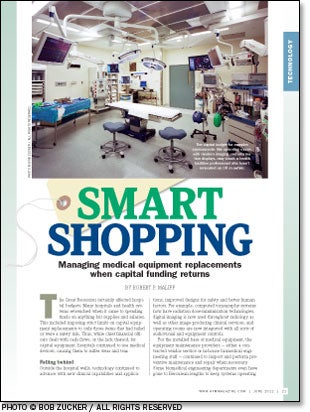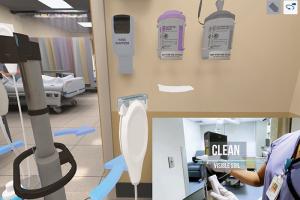Smart shopping
 The Great Recession certainly affected hospital budgets. Many hospitals and health systems retrenched when it came to spending funds on anything but supplies and salaries. This included imposing strict limits on capital equipment replacements to only those items that had failed or were a safety risk. Thus, while chief financial officers dealt with cash flows, or the lack thereof, for capital equipment, hospitals continued to use medical devices, causing them to suffer wear and tear.
The Great Recession certainly affected hospital budgets. Many hospitals and health systems retrenched when it came to spending funds on anything but supplies and salaries. This included imposing strict limits on capital equipment replacements to only those items that had failed or were a safety risk. Thus, while chief financial officers dealt with cash flows, or the lack thereof, for capital equipment, hospitals continued to use medical devices, causing them to suffer wear and tear.
Falling behind
Outside the hospital walls, technology continued to advance with new clinical capabilities and applications, improved designs for safety and better human factors. For example, computed tomography systems now have radiation dose-minimization technologies, digital imaging is now used throughout radiology as well as other image-producing clinical services, and operating rooms are now integrated with all sorts of audiovisual and equipment controls.
For the installed base of medical equipment, the equipment maintenance providers — either a contracted vendor service or in-house biomedical engineering staff — continued to inspect and perform preventive maintenance and repair when necessary. Some biomedical engineering departments even have gone to Herculean lengths to keep systems operating by scrounging for spare parts on eBay. However, many hospitals now are using devices that are well beyond what a clinician would consider reasonable, which may put staff and patients at risk.
Another big change that took place during these times of restricted capital was the introduction of the Health Information Technology for Economic and Clinical Health Act, which provided funds for greater implementation of electronic medical records (EMRs).
With its meaningful use requirements pushing greater integration of medical devices with EMRs, there are many more hospitals considering what medical equipment might be tied into EMRs. However, as the existing base of medical equipment has aged, some devices may be difficult to integrate with their current operating software versions.
Also, it may not be cost-effective to integrate devices that are planned to be replaced soon with newer technology platforms. The effort of updating software versions or developing EMR-specific device interfaces, for what may amount to just one or two years' worth of use before the device is replaced, is a new issue that must be accounted for in capital budgeting processes.
Finally, while replacing existing devices is one major issue, the never-ending introduction of new technologies also has placed demands on any available capital funds. Whether it's alarm integration technologies or breast tomosynthesis, clinicians often request new equipment that expands clinical services. In some cases, marketing decisions also affect new installations. Whatever the cause, buying new technologies is often a sexier idea than replacing a ventilator, and both propositions compete for limited medical equipment funds.
Importance of analysis
Will newly available capital trigger a flood of technology investment? And, if so, how will the replacement technologies impact the built environment?
Much depends on the age of a health care facility. However, it's a safe bet that some alterations and renovations to the physical infrastructure will be required. The costs of these requirements typically are overlooked in the acquisition process, which is a big mistake.
So how does a hospital allocate limited capital for medical devices? How does this impact information technology (IT) investments and facility upgrades that also are competing for the same funds?
Usually hospitals have separate budgets for their medical, IT and facility needs with the latter two often handled via projects like an EMR implementation or new patient tower project.
It's a battle between replacement funding and strategic project funding. In many instances, administrators may put routine capital replacement into funding for their own projects, which can put a large dent in the original budget plan. While this might be acceptable in some financial scenarios, donor-funded projects like a new neonatal intensive care unit named for a local benefactor often have restrictions on what can be purchased.
In richer times, when capital operating budgets were healthier and money was more readily available, the fight for funding was not so intense. Hospitals routinely replaced aging equipment and invested in new programs. While a return on investment was performed, it may have been a cursory effort.
Today, hospitals and health systems have much stricter analysis requirements. While a negative return may be accepted, even a positive analysis should be thoroughly vetted for accuracy and validity. However, even in these tough financial times, capital equipment replacements should not be halted.
Tips for transparency
Transparency in capital funds allocation is one requirement of a successful capital budget program. After all, with such high demands, any perceived favoritism will ruin the process and contribute to staff dissatisfaction and negative feelings. But how does a health system transparently allocate capital funds?
The easiest way to prioritize replacement may be to look at the age of equipment and any associated financial depreciation. However, financial depreciation is different from clinical depreciation — the two are linked, but only loosely. A good inspection and preventive maintenance program can extend the useful life of a medical device beyond its normal life span, which may exceed a seven-year financial depreciation schedule.
For this reason, the age of equipment is not a true indicator of the need for replacement. Depending on how the device is treated and what the maintenance program does to assure that the equipment is performing well, the average useful life of a device relies on each facility's workflow and use environment.
Transparency requires that clinicians know that the squeaky wheel tactic does not get the grease and, instead, that patient care and long-term health of the hospital drive capital replacement decisions. To achieve more transparency, the nonprofit ECRI Institute, Plymouth Meeting, Pa., has worked with many health systems to institute capital replacement planning processes that include some of the following factors:
Clinical. What are the technology capabilities required to meet standard of care or clinical needs for the patient mix and procedures offered?
Operational. What are the effects on departmental and organizational workflow?
Life cycle. What is the performance, reliability and parts availability of the technology? Is the existing technology obsolete or will it become obsolete within the next several years?
Safety. Does the current complement of technology pose any predictable safety hazards for patients or staff? Is the technology available to enhance or strengthen patient and staff safety?
Strategic. What is the planned direction of the clinical service? What role will medical technology play in supporting that program?
These guidelines lead to more than a wish list of technology and may even prevent the physician's returning from a conference demanding the latest and greatest devices.
Evaluating needs
To begin the capital replacement planning process, the clinical departments and service lines should evaluate their capital needs according to the aforementioned factors. Then, a second review should include purchasing, implementation and support departments.
The opinions of the purchasing department are essential to the process because it is responsible for putting required terms and conditions into place before a proposal is agreed upon and a purchase order is cut. More importantly, the purchasing department ensures that standardization and bundling efforts are maximized.
Input from the IT department also is required because medical devices are routinely networked. IT also should confirm communication and integration support needs. The biomedical engineering department is essential to supporting and coordinating the evaluations of the purchasing and IT departments and to identifying training needs for maintenance support as well as evaluating any safety, life cycle and operational claims.
It is also important that the facilities department review capital requests. In many cases, hospitals procure equipment that requires extensive room renovations once it arrives on-site. While these additional reviews may be seen as road blocks, near-complete information regarding communication needs, floor loading requirements, vendor standardization and required HVAC alterations is essential to ensuring a smooth go-live after the equipment arrives on the loading dock.
Once reviews are complete, a capital replacement committee can prioritize the requests based on the hospital or health system strategy. Where appropriate, clinical champions should be heard in person, rather than relying on paper or electronic information submissions. Many hospitals have incorporated clinicians into the process to ensure that everyone is on board with the final results.
Those in charge of a successful replacement plan should communicate their progress and celebrate the funding of capital through announcements and routine internal press and marketing opportunities once new equipment is installed and becomes operational.
Real-world examples
Recently, ECRI worked with a large health system that acquired a community hospital with capital limitations and, in fact, was still operating with limited capital under the new parent company. However, the owner wanted a better understanding of the emergent capital replacement needs for its newest facility.
After conducting a thorough analysis of the inventory, more than $21 million dollars' worth of capital needs over the next few years were identified. It also was discovered that the inventory was largely outdated.
The capital replacement amount was based on age as well as safety, maintenance and integration needs. Because the radiology-based devices were maintained by a different service organization, a complete listing of the equipment in the hospital did not exist. Just the process of closely looking at capital replacement needs corrected a major gap in knowledge, resulting in improved maintenance management.
This capital replacement plan will serve as the basis for future capital budgeting decisions. While allocated funds may vary from the established plan, especially as the hospital corrects other discrepancies in its inventory, the plan will flex as funding, strategy, safety and maintenance programs change.
Another health system with which ECRI worked devolved its capital replacement decisions from the C-suite to a physician- and director-led group with several key directors.
Members of the C-suite group were having difficulties keeping the capital replacement process on schedule, because they were receiving requests with incomplete information and always were postponing decisions until the further information arrived. They also found themselves too removed from the actual use of the medical equipment to have an understanding of the true needs.
The process was transitioned to a director-level committee to assess and prioritize the information, and then make recommendations to the C-suite team for its approval. The senior administrators made decisions on an up or down vote. This new process made the clinicians feel more involved with the capital replacement process and decisions were made more quickly.
Each of these capital replacement processes will be different. However, each should be transparent and encompass more meaningful information related to safety and strategy, as opposed to age.
Managing change
While medical technology will continue to change and requests will never end, a good capital replacement process can help manage this change and objectively handle these requests.
Robert Maliff is a director for the applied solutions group at ECRI Institute, Plymouth Meeting, Pa. He can be reached at rmaliff@ecri.org.
| Sidebar - Getting ready for EMR integration |
| In the old days — and still in many hospitals today — nurses and doctors spend a good portion of each shift transcribing information into the patient's medical chart. Not only is this process rife with problems and prone to error, it takes health care clinicians away from their primary task — caring for the patient. As electronic medical records (EMRs) become more widely used, hospitals are moving to integrate medical devices into their EMRs. This will allow automatic charting of data like vital signs, automatic entry of weight and other physiological parameters when seen in preadmission testing, and countless other applications where data can be captured automatically. Thermometers, infant warmers, spirometers, physiologic monitors, ventilators, patient scales, blood glucose monitors and many other devices can be integrated into the EMR. The work required to make these changes will be worth it in terms of patient safety and workflow improvements. However, health facilities professionals need to ask themselves one question: Is the hospital's medical equipment capable of being integrated? Sometimes it's not worth the effort to develop customized interfaces for medical equipment, especially if the device in question is nearing the end of its clinical useful life. The clinical and workflow benefits have to be weighed against the interface development effort for older equipment. Going forward, though, hospitals should purchase equipment that is specifically designed and ready for integration. Although not quite near the plug-and-play stage, medical device suppliers are focusing on making integration easier. Integrating the Healthcare Enterprise (IHE) is one organization that addresses integration. IHE has developed profiles based on clinical workflows, and medical device suppliers can indicate whether or not they support the relevant profile. There are domains for patient care, laboratory, pharmacy, eye care, radiation oncology and more types of devices. All supply chain departments should be working with their information technology and biomedical engineering departments to ensure that only medical equipment that supports applicable IHE profiles are purchased. More information on IHE can be accessed at -www.ihe.net. |
| Sidebar - Managing million-dollar equipment requests |
| While every hospital department is trying to get its hands on new funding, it seems as though radiology departments request millions in capital equipment each year. And that's in a lean year. However, the fight for funding can't be viewed by each hospital department as a win-lose situation, with every department harboring bad feelings toward radiology in the end. If the capital budget allocation process is done behind closed doors with no or minimal clinician input, health facility professionals are going to have a mutiny on their hands. Every doctor will be trying to curry favor; the nursing and allied health staff will lose interest as they feel that their requests continue to go unheard year after year; and soon there will be no capital budget process in place because it will have broken down entirely. By incorporating clinical champions when necessary, routinely communicating progress and releasing funds in a timely manner, a hospital can engage its staff and physicians so that there are no surprises. And while it may seem like a strange idea in these austere times, health facilities professionals must try their best to secure an emergency reserve fund to cover unexpected equipment failures. |




